Angkor - the jewel of Cambodia

a few words on the Khmer legacy.. The Khmer Empire was based at Angkor for much of the period from the 9th centuryto the 15th century. The name 'Angkor' translates as 'the city that is a temple'. These guys were BIG time, throwing up massive and intricate buildings & elaborate waterways and reservoirs. They were heavily influenced by the culture & religion from India, at the same time China was starting to discover India in the North, so it was a major turning point in the history of Asia. The Indian Empire spread through trade and commerce, their ships were among the first to brave the seas and push East across the Indian ocean. The Khmers believed that temples (as in India) should be built according to certain mathematical principals in order to function in harmony with the universe. This also explains why the acoustics in some of the halls and passageways are still astounding to this day. i wonder how many contemporary architects think about their buildings functioning in harmony with the universe? many of temples are only 1 story high and much of the ceilings have collapsed, but you can still feel the size of the structures.
These temples are a shrine to the Khmer universe (and the Hindu God Vishnu), you feel very small indeed while exploring here, far smaller than you do in a modern day metropolis like London. They may not have our skyscrapers but they knew how to build and create a sense of grandeur. Almost all the stone, many million tonnes of it (much of it sandstone) was dragged by elephants from the mountains over 20 miles away, you can still see the holes in the blocks into which wooden rods were attached. As the population increased so did the demand on the Khmer's infrastructure, the popular theory for the empire's decline is that deforestation and problems with maintaining the rice (the principal source of food along with fish) harvest meant life in the area could not be sustained. Angkor was also invaded and pillaged several times over, the area was the scene of many a battle of which there is little or no written record. Most of the residential buildings were made of wood, so have long since decayed. What's really amazing in that hardly any work has yet been done beneath the ground, so who knows what archaeological mysteries are waiting to be uncovered. Maybe the Khmer's built underground caverns and homes to escape the heat and monsoons?
The image below was taken from space in 2004; the big dark rectangle is the Western Baray, an enormous reservoir built to provide water for irrigation. That means the Khmers were growing a LOT of rice and veg! It's almost 2km x 7km and fed a very elaborate system of dykes, moats & canals. this system is amazingly far more evolved than anything used in modern day Cambodia. The water was drawn from the huge lake Tonle Sap to the south, which is also where all the fish came from (and still does). the dark square just below and to the right is the main Angkor Wat temple complex, surrounded by moat which is still filled with water to this day. It's almost a mile square...massive.

Located to the north of the Great Lake (Tonle Sap) near modern day Siem Reap. The temples in the Angkor area number over one thousand, ranging in scale from nondescript piles of brick rubble scattered through rice fields to the massive and awe inspiring Angor Wat (the largest religious building in the world). The temples vary greatly in size, shape and design, however the common thread is that they were all built with great care and purpose.
In the last decade, as the country recovers from the brutal Khmer Roung regime, the tourist trade has flourished in Siem Reap, new hotels and resorts (many 5 star) are popping up every month.. feels kinda like a historical theme park sometimes. At it’s height the Angkor empire, centred around the city of Angkor Thom was populated by 1 million + at a time when London was a small town of 50,000! The tourist trade in Cambodia as a whole will take longer to build up, many areas of the countryside are still no go due to over 10 million landmines scattered during he regime (one for each person in Cambodia). The beaches on the south coast, although few in number are almost deserted and stunning. The islands off the coast will soon be developed for hotels and resorts, apparently wealthy Russian property developers have purchased many of them.
We arrived early evening and were met by a friend of Tim’s family named Meta. He works p/t as a guide to the temples so was kind enough to give us an excellent 2 day itinerary. Some say you should spend a week here, not rushing around to make the most of the temples. However, we only had 3 days so had to plan carefully and keep our eyes open. You could never see it all in one go anyway, this is somewhere to return a few times in a lifetime. Our guest house was well located and our 'tuctuc' man turned out to be a very reliable and good humored driver. Siem Reap is a very dusty town, the roads have yet to be tarmacked (which is strange when you see 100’s of hotels appearing everywhere). There are also crazy bugs and moths which congregate in their thousands at every light source, though fortunately not too many mosquito's!
the temples..
Ta Prohm
 This temple is one of many in Angkor to have been invaded by the surrounding jungle. In many cases the tress have grown and covered the ruins, & removing them would mean collapse of the walls, so they have become part of the structures and create an incredible atmosphere. You truly feel like you are stepping back in time. In one of the courtyards, the roof of which has long since collapsed you can see a smiling face through the roots of a tree (left), still happy after almost 200 years! Considering the derelict state of many of the temples it's surprising that visitors are allowed to clamber over, under and around them.. you wonder how many hapless tourists have been crushed by a dislodged 2 tonne stone while trying to get that postcard shot..
This temple is one of many in Angkor to have been invaded by the surrounding jungle. In many cases the tress have grown and covered the ruins, & removing them would mean collapse of the walls, so they have become part of the structures and create an incredible atmosphere. You truly feel like you are stepping back in time. In one of the courtyards, the roof of which has long since collapsed you can see a smiling face through the roots of a tree (left), still happy after almost 200 years! Considering the derelict state of many of the temples it's surprising that visitors are allowed to clamber over, under and around them.. you wonder how many hapless tourists have been crushed by a dislodged 2 tonne stone while trying to get that postcard shot..The (terrible) film ‘Tomb Raider’ uses this temple as a primary location, many tourists visit just to see the ‘tomb raider tree’, located near the entrance. it's very sad, especially when you hear that the film crew damaged and re-landscaped land around the temples. Luckily for us the area has many hidden, shaded and quiet halls so you can escape the hoards of tourists. There was a very special vibe here, who can imagine the buzz of activity around here 1000 year's ago?
It won’t be long before access to the temples is restricted, knowing this, you feel fortunate to climb and explore the stones at your leisure. I can remember being a young boy and clambering over Stonehenge in Somerset (i have photos!) before they put up the fences.. This temple is undergoing a massive restoration project by the Cambodian government and Indian agencies. The trees themselves must also be conserved, there's over 250 ancient trees in this temple alone.
The Bayon
A towering temple, once adorned with almost 200 smiling faces (many 20ft high) all facing different directions. One of the last to be built and situated at the exact centre of the city of Angkor Thom, roads lead in all directions away from the site, you get the feeling of being at the very core of the city. The exact meanings of the these faces and the carvings remain a mystery, some believe the faces may resemble King Jayavarman VIII. This site housed 2 libraries and was a central place of worship and study for the Angkor population. There was a big group of tourists on site when we arrived, but thanks to the small, hidden hallways and courtyards we could still find quiet spots. One of our group managed to sprain his ankle here, which must happen on a daily basis as the steps are so steep, crooked and often slippery.
The Terrace of the Elephants
 This 350m long terrace was used for viewing troops and public ceremonies, the king who built it (Jayavarman V11) could look out on his gloriously victorious returning armies with pride. We were lucky to see this area at sunset, which meant most of the tourists had wandered off the Baphoun temple mountain (the prime sunset spot, more on that later).
This 350m long terrace was used for viewing troops and public ceremonies, the king who built it (Jayavarman V11) could look out on his gloriously victorious returning armies with pride. We were lucky to see this area at sunset, which meant most of the tourists had wandered off the Baphoun temple mountain (the prime sunset spot, more on that later).Most of the structure was originally built using organic materials so has long since decayed, but you get the sense of grandeur and royal occasion walking along the raised bridges and platforms.
Moats surround much of area and elephant carvings adorn all the walls, especially along the side facing the open park area, they remain amazingly clearly rendered. You can imagine scores of massive elephants striding around majestically in all their splendor.
Angkor Wat
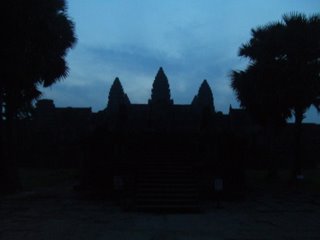
Angkor Wat at Sunrise
It’s impossible to describe the feeling of approaching this massive temple, you are simply lost for words as you walk the bridge which connects the entrance to the temple gate. no amount of superlatives would do it justice.
I rose early (4.30am) to get there for sunrise, 500 Japanese tourists had the same idea, so I walked on ahead into the temple itself to find some peace as the dawn broke. Surprisingly I had the whole area to myself, with the crowds waiting outside by the lake (the most popular sunrise spot). I saw the ancient stone slowly becoming illuminated by the rising sun with only the sound of birdsong to accompany me. the best time for photos is the 2 hrs after sunrise and 2 hrs before sunset, as the sun blares down too bright the rest of the day... I did not take as many photos here as some of the other temples, preferring instead the wander around the perimeter and gradually work my way inwards. our friend Meta suggested this was the best way to approach all the temple, rather than (as many tourists do) heading straight up the centre aisle.
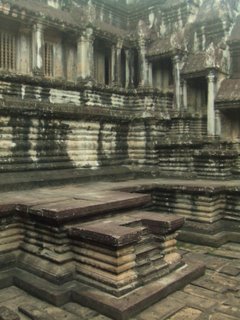 The sheer scale and grandeur of this place can be compared only to the giant constructions of Egypt and Rome (the perimeter is almost 1000m sq), at the same time each hallway and courtyard reveal great attention to detail and some of the best preserved engravings can be found here. Angkor Wat became a Buddhist shine from the 14th century, so has been better preserved than many other temples. To this day, Buddhist monks have residence within the temple grounds and work with other groups from India and others to preserve the structure. The bas reliefs along temple walls cover almost 4000 ft of polished sandstone.. 4000 ft!!! you can't even begin to imagine how many years the Khmers spent decorating this, just mind blowing.
The sheer scale and grandeur of this place can be compared only to the giant constructions of Egypt and Rome (the perimeter is almost 1000m sq), at the same time each hallway and courtyard reveal great attention to detail and some of the best preserved engravings can be found here. Angkor Wat became a Buddhist shine from the 14th century, so has been better preserved than many other temples. To this day, Buddhist monks have residence within the temple grounds and work with other groups from India and others to preserve the structure. The bas reliefs along temple walls cover almost 4000 ft of polished sandstone.. 4000 ft!!! you can't even begin to imagine how many years the Khmers spent decorating this, just mind blowing.Cambodians have a huge national pride for Angkor Wat, to such an extent that a depiction of the temple has always featured on their national flag (no other country has a building on their flag). The temples are the main tourist draw to Cambodia and UNESCO are working hard with Cambodian government to ensure the massive influx (now 1 million per year+) does no lasting damage to the environment. One change will be a ban of all motor vehicles around the temples, switching instead to electric cars and tuctuc's. It is also crucial for the local Cambodia people to build their lives up again and not just rely on tourism, otherwise the developers are free to construct their 5 star hotels with cheap labour and the cycle continues..
Ta Som
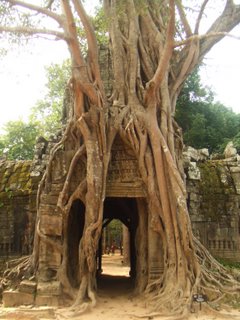
A smaller Buddhist temple, again featuring many overgrown trees covering the walkways and arches, Ta Som had a very peaceful vibe. I had a few tips from one of the temple guards here and found some hidden carvings along the walls. you wonder what actually happened here, in these vast halls and walkways... very little artwork of carving tells you about life in Khmer times, instead they depict the great battles of good and evil, hell, heaven and earth.. you feel the Khmers faith everywhere.
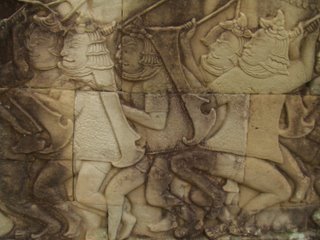
Preah Khan
 A long, flat temple with a great number of well preserved carvings and relief’s. This was the site of the kings entertainments, housing over 1000 dancers and all kinds of feasts. A local guide explained the significance of the carvings, After hours and around town..Siem Reap is built for tourists, bars and restaurants are concentrated around the central markets and there’s even a street called ‘bar street’. Many Westerners run venues hear, you can see English style pubs and bars with pool and ‘happy pizzas’ on every corner. The markets and local shops are much the same as other towns in Cambodia and Vietnam, all selling the same silks, scarves, bags and souvenirs. Although I did find some stores which were supporting local street kids and those affected by land mines, many selling arts and crafts made by locals which was a refreshing change.
A long, flat temple with a great number of well preserved carvings and relief’s. This was the site of the kings entertainments, housing over 1000 dancers and all kinds of feasts. A local guide explained the significance of the carvings, After hours and around town..Siem Reap is built for tourists, bars and restaurants are concentrated around the central markets and there’s even a street called ‘bar street’. Many Westerners run venues hear, you can see English style pubs and bars with pool and ‘happy pizzas’ on every corner. The markets and local shops are much the same as other towns in Cambodia and Vietnam, all selling the same silks, scarves, bags and souvenirs. Although I did find some stores which were supporting local street kids and those affected by land mines, many selling arts and crafts made by locals which was a refreshing change.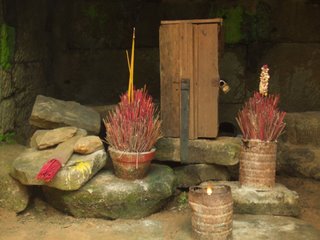 You find small shrines like this all over Angkor, sometimes a monk is there to pass you incense but in this case it was completely deserted and hidden under a wall by one of the reservoirs.. very peaceful spot. Most homes, shops and restaurants in SE Asia have some kind of shrine clearly visible, to bless the space and ward off evil spirits.
You find small shrines like this all over Angkor, sometimes a monk is there to pass you incense but in this case it was completely deserted and hidden under a wall by one of the reservoirs.. very peaceful spot. Most homes, shops and restaurants in SE Asia have some kind of shrine clearly visible, to bless the space and ward off evil spirits.
